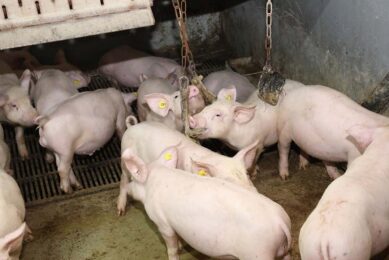Artificial rearing affects piglets pre-weaning

Artificial rearing impairs piglet behaviour, welfare and growth. That in short is the conclusion of joint Irish and Scottish research that was recently published.
The scientists, attached to the Irish research institute Teagasc, Scotland’s Rural College and The University of Edinburgh, published their findings in the peer-reviewed journal Applied Animal Behaviour Science.
Artificial rearing as strategy
The scientists explained in their article that, in order to deal with managing large litters, one strategy involves removing piglets from their mothers at 7 days old to be reared in specialised accommodation with milk replacer. In the study, the team evaluated effects on piglet behaviour, growth and some aspects of welfare by comparing 10 pairs of 2 litters (one sow-reared, one artificially-reared) selected at 7 days-old at a similar weight.
The team recorded piglet behaviour for 20 minutes following transfer of artificially-reared piglets to the artificial-rearing enclosure (day 0) and for 20 minutes hourly between 9am and 5pm (8 hours) on day 5 and day 12. They also undertook 5 minute live observations every hour. The team also conducted Qualitative Behavioural Assessment (QBA) on day 14 to evaluate piglets’ emotional state. Survival and illness events were recorded until weaning.
In addition, they weighted and scored the piglets for tear staining, dirtiness of the face and severity of lesions of the snout, limbs, ear and tail, on day 0, day 1, day 8 and day 15. Survival and illness rates, as well as the rates of behaviours/minute were analysed, just like weights and QBA scores. In addition, lesions, tear staining and dirtiness scores were averaged per litter and analysed.
Differences in the piglets’ behaviour
The researchers wrote in their article: “When artificially-reared piglets were transferred to the artificial-rearing enclosure, their behaviour was not different to sow-reared piglets. Over the 2 observation days, artificially-reared piglets performed more belly-nosing, nursing-related displacements, visits to the milk cup (compared to nursing bouts), and oral manipulation of littermates’ ears and tails than sow-reared piglets.
The Irish institute Teagasc was also involved in a study to the detection of ear biting using PLF technology
“However, sow-reared piglets played alone and explored their environment more frequently than artificially-reared piglets. The QBA scores indicated a lower emotional state in artificially-reared piglets. Survival rate and overall illness rate of piglets were similar between the treatments.”
Growth check following transfer to enclosure
“Artificially-reared piglets experienced a growth check following their transfer to the artificial-rearing enclosure and remained lighter than sow-reared piglets through to weaning. Overall, snout lesion scores were not different between the treatments, but artificially-reared piglets had lower limb and ear lesion scores and higher tail lesion scores. Artificially-reared piglets were dirtier but had lower tear staining scores than sow-reared piglets.”
All in all, the results led the team to conclude that artificial rearing does impair piglet behaviour, welfare and growth.
The article which appeared in Applied Animal Behaviour Science was conducted by Keelin O‘Driscoll and Laura A. Boyle, Teagasc, Ireland; Emma M. Baxter, SRUC, Scotland, UK; and Océane Schmitt, attached to Teagasc, SRUC and the University of Edinburgh, Scotland, UK.
 Beheer
Beheer








 WP Admin
WP Admin  Bewerk bericht
Bewerk bericht